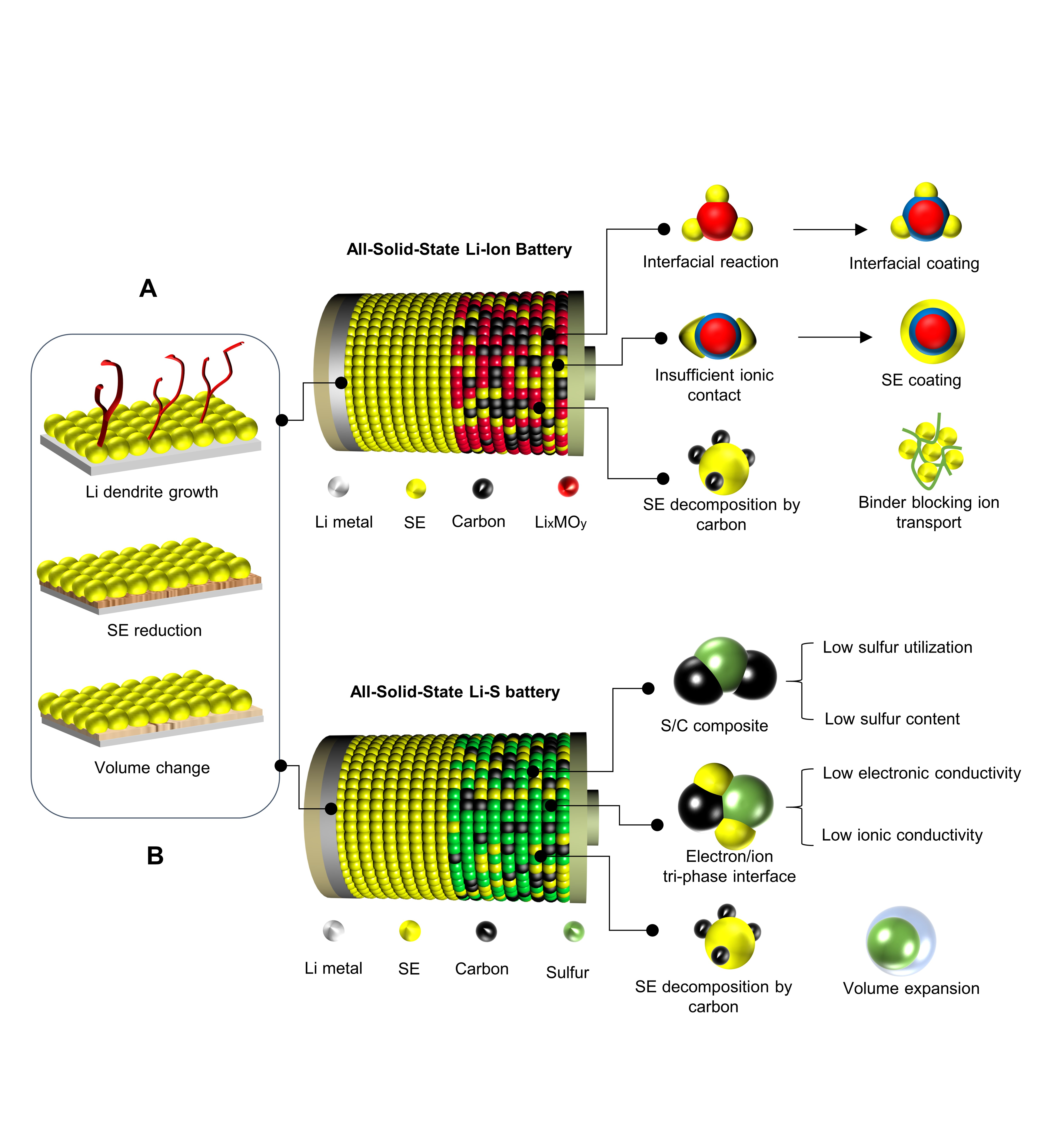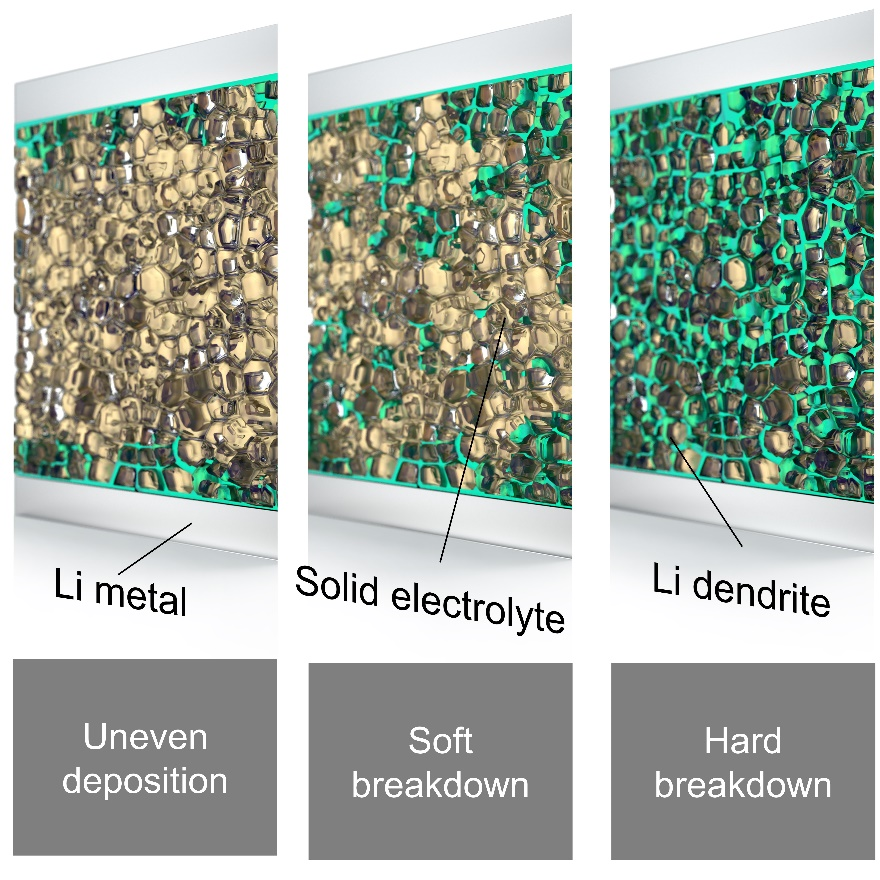All-solid-state batteries are a revolutionary advancement in battery technology that holds the potential to address several limitations associated with traditional lithium-ion batteries. Unlike conventional batteries that use liquid electrolytes, all-solid-state batteries (ASSBs) employ non-flammable solid-state electrolytes, thus offering numerous advantages, including improved safety, energy density, cycle life, and excellent low-temperature performance. Our interdisciplinary research group is committed to developing revolutionary ASSBs from the perspectives of materials design, interface engineering, and manufacturing technique, which covers the following research directions:
1. Solid-State Electrolyte Design
A solid-state electrolyte is a core material for next-generation solid-state batteries, which requires high ionic conductivity, low electronic conductivity, wide electrochemical window, low cost, and good viability for large-scale manufacture. Our research at the material level mainly covers solid-state oxide electrolytes, sulfide electrolytes, halide electrolytes, and polymer electrolytes, of particular interest to understanding the structure-to-property relationships via advanced characterizations, such as X-ray diffraction, X-ray absorption spectroscopy, neutron diffraction, and cryogenic electron microscopy (Cryo-EM).

Figure 1. The comparison of room-temperature ionic conductivity and electrochemical window
of various solid-state electrolytes.
Selected Publication:
1.
C. Wang,J. Liang, J-T Kim, X. Sun.
Prospects of halide-based all-solid-state batteries: From material design to practical application.
Science Advances, 8,eadc9516(2022).View More
2.
C. Wang‡,J. Liang‡, ... J.Wang*,X. Sun*.A Universal Wet-Chemistry Synthesis of Solid-State Halide Electrolytes
for High-Performance All-Solid-State Lithium Metal Batteries.
Science Advances,7(2021).View More
2. Interface Engineering
The suboptimal performance of all-solid-state batteries is mainly attributed to slow ion and electron transport due to detrimental interfacial reactions and insufficient solid-solid contact. Resolving these issues is crucial for enhancing battery efficiency. Designing compatible interfaces, engineering interfacial structures, developing stable materials, and utilizing advanced analytical methods are key strategies to address these challenges and improve the overall performance, safety, and durability of all-solid-state batteries.

Figure 2. Schematic illustration of interface challenges of all-solid-state batteries, including all-solid-state Li-ion batteries and all-solid-state Li-S batteries.
Selected Publications:
1. C. Wang‡, S
... C. V. Singh,* D. Su,* X. Sun*. Deciphering Interfacial Chemical
and Electrochemical Reaction Mechanism of Sulfide-based All-Solid-State Batteries. Advanced Energy
Materials, 2021,
View More .
2. C. Wang, K. Adair,
X. Sun. All-Solid-State Lithium Metal Batteries with Sulfide Electrolytes: Understanding Interfacial Ion and Electron Transport.
Accounts of Materials Research. 2022, 3, 1, 21-32.
View More .
3. Practical Manufacturing of All-Solid-State Pouch Cells
Not only fundamental understanding but practical engineering of all-solid-state pouch cells is also indispensable for their commercial success, such as electrode engineering, ultrathin solid electrolytes, and high throughput manufacturing with a low cost. Our group has successfully developed dry electrode technologies to fabricate ultrathin and freestanding solid-state electrolyte membranes (15µm) and thick solid-state electrodes (4~8 mAh.cm-2), which are stacked together to form all-solid-state pouch cells.

Figure 3. A) Schematic of all-solid-state pouch cell preparation process with solvent-free approach. B) The photos of freestanding electrodes and solid electrolyte membranes. C) A photo of an all-solid-state pouch cell (left) and a photo of an all-solid-state pouch cell lighting a LED (right).
Selected Publications:
1. C. Wang‡,
, ... J. Wang*, S. Zhao*, H. Huang*, X. Sun*. Solvent-Free Approach for Interweaving Freestanding
and Ultrathin Inorganic Solid Electrolyte Membranes, ACS Energy Letters, 2022, 7, 410–416.
View More
2. C., Wang
,... Sun*. All-Solid-State Lithium Metal Batteries Enabled by Sulfide
Electrolytes: from Fundamental Study to Practical Engineering Design. Energy & Environmental Science,
2021, 14, 2577-2619.
View More
4. Failure Mechanisms of All-Solid-State Batteries
All-solid-state batteries, while holding promise for improved energy storage, face several failure mechanisms that hinder their performance and safety. The typical failure mechanisms include interfacial instability, dendrite formation, soft, breakdown, thermal expansion mismatch, electrolyte decomposition, strain effects, electrochemical side reactions, and thermal runaway. Addressing these challenges requires innovative solutions in materials design, interface engineering, manufacturing techniques, and thermal management. Understanding these failure mechanisms is vital to fully realize the potential benefits of all-solid-state batteries, including increased energy density, enhanced safety, and extended cycle life.

Figure 4. Schematic of lithium dendrite formation in Li/SE/Li symmetric cells.
Selected Publications:
1. C., Wang,T Deng,
X Fan, M Zheng, R Yu, Q Lu, H Duan, H Huang, C Wang, X Sun, Identifying soft breakdown in all-solid-state
lithium battery. Joule, 6.8 (2022): 1770-1781.
View More
Copyright © 2023 Wang All rights reserved.